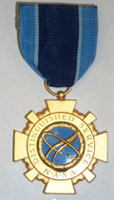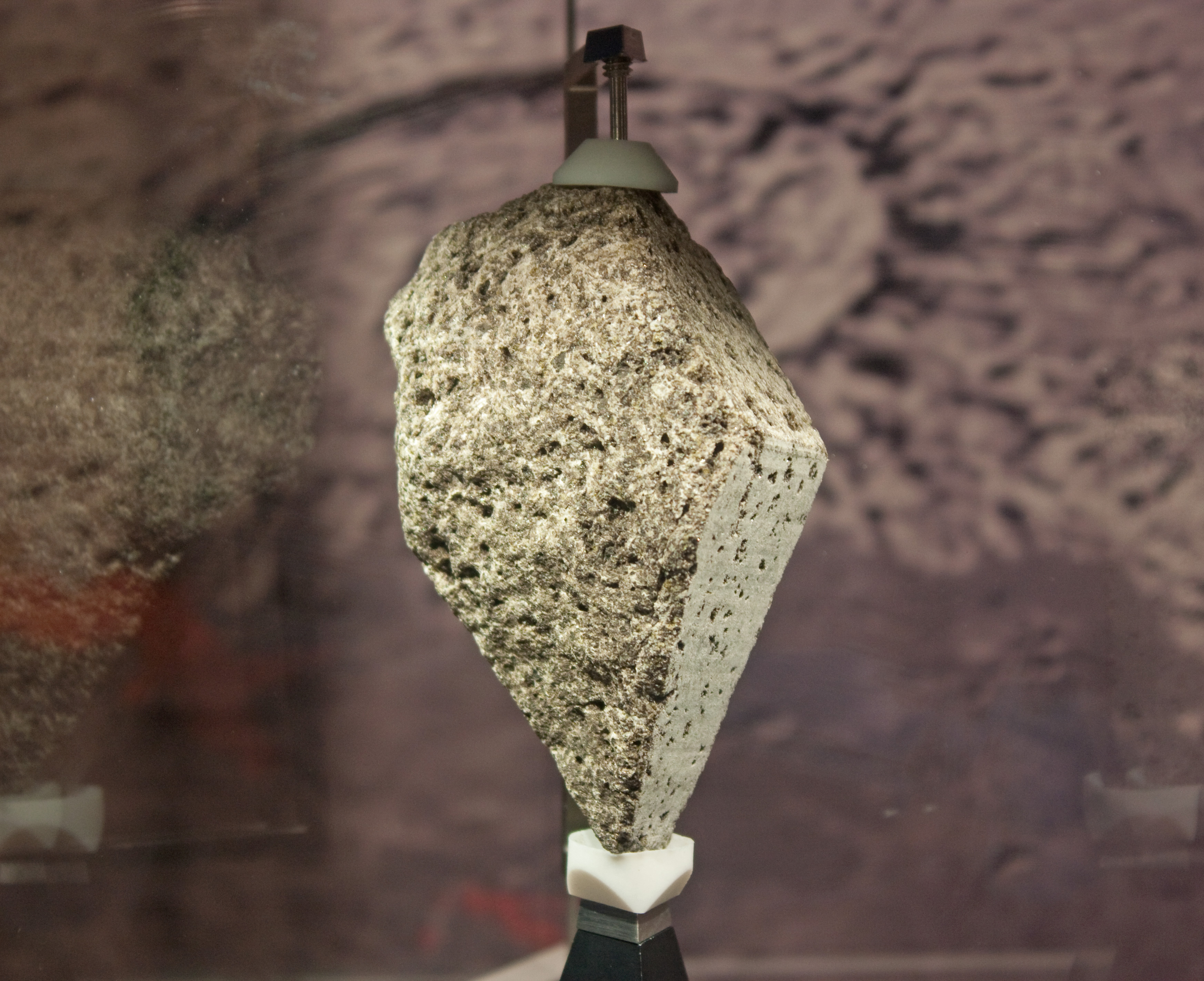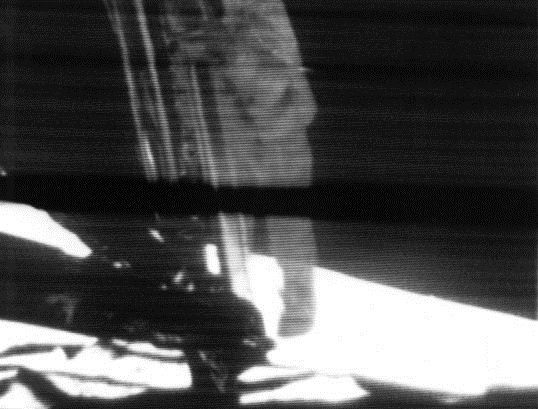|
Apollo 14
Apollo 14 (January 31, 1971February 9, 1971) was the eighth crewed mission in the United States Apollo program, the third to land on the Moon, and the first to land in the lunar highlands. It was the last of the " H missions", landings at specific sites of scientific interest on the Moon for two-day stays with two lunar extravehicular activities (EVAs or moonwalks). The mission was originally scheduled for 1970, but was postponed because of the investigation following the failure of Apollo 13 to reach the Moon's surface, and the need for modifications to the spacecraft as a result. Commander Alan Shepard, Command Module Pilot Stuart Roosa, and Lunar Module Pilot Edgar Mitchell launched on their nine-day mission on Sunday, January 31, 1971, at 4:03:02 p.m. EST. En route to the lunar landing, the crew overcame malfunctions that might have resulted in a second consecutive aborted mission, and possibly, the premature end of the Apollo program. Shepard and Mitchell m ... [...More Info...] [...Related Items...] OR: [Wikipedia] [Google] [Baidu] |
Stuart Roosa
Stuart Allen Roosa (August 16, 1933 – December 12, 1994) was an American aeronautical engineer, smokejumper, United States Air Force pilot, test pilot, and NASA astronaut, who was the Command Module Pilot for the Apollo 14 mission. The mission lasted from January 31 to February 9, 1971, and was the third mission to land astronauts (Alan Shepard and Edgar Mitchell) on the Moon. While Shepard and Mitchell spent two days on the lunar surface, Roosa conducted experiments from orbit in the Command Module ''Kitty Hawk''. He was one of 24 men to travel to the Moon, which he orbited 34 times. Biography Early life and education Roosa was born on August 16, 1933, in Durango, Colorado, to parents Dewey Roosa (1903–1988) and Lorine Roosa (; 1908–1993) and grew up in Claremore, Oklahoma. He attended Justus Grade School and Claremore High School in Claremore, Oklahoma, from which he graduated in 1951. Thereafter, he studied at Oklahoma State University and the University of Arizona, ... [...More Info...] [...Related Items...] OR: [Wikipedia] [Google] [Baidu] |
Alan Shepard
Alan Bartlett Shepard Jr. (November 18, 1923 – July 21, 1998) was an American astronaut, naval aviator, test pilot, and businessman. In 1961, he became the second person and the first American to travel into space and, in 1971, he became the fifth and oldest person to walk on the Moon at age 47. A graduate of the United States Naval Academy at Annapolis, Shepard saw action with the surface navy during World War II. He became a naval aviator in 1946, and a test pilot in 1950. He was selected as one of the original NASA Mercury Seven astronauts in 1959, and in May 1961 he made the first crewed Project Mercury flight, Mercury-Redstone 3, in a spacecraft he named ''Freedom 7''. His craft entered space, but was not capable of achieving orbit. He became the second person, and the first American, to travel into space, and the first space traveler to manually control the orientation of his craft. In the final stages of Project Mercury, Shepard was scheduled to pilot the Mer ... [...More Info...] [...Related Items...] OR: [Wikipedia] [Google] [Baidu] |
Golf Ball
A golf ball is a special ball designed to be used in the game of golf. Under the rules of golf, a golf ball has a mass no more than , has a diameter not less than , and performs within specified velocity, distance, and symmetry limits. Like golf clubs, golf balls are subject to testing and approval by The R&A (formerly part of the Royal and Ancient Golf Club of St Andrews) and the United States Golf Association, and those that do not conform with regulations may not be used in competitions ''(Rule 5–1)''. History Early Balls It is commonly believed that hard wooden, round balls, made from hardwoods such as beech and box, were the first balls used for golf between the 14th through the 17th centuries. Though wooden balls were no doubt used for other similar contemporary stick and ball games, there is no definite evidence that they were actually used in golf in Scotland. It is equally, if not more likely, that leather balls filled with cows' hair were used, imported from th ... [...More Info...] [...Related Items...] OR: [Wikipedia] [Google] [Baidu] |
Cone (crater)
Cone crater is a small crater in the Fra Mauro highlands, north of Fra Mauro crater, on the Moon. The name of the crater was formally adopted by the IAU in 1973. The Apollo 14 astronauts Alan Shepard and Edgar Mitchell landed the Lunar Module (LM) ''Antares'' southwest of Cone crater on February 5, 1971. During the descent, Cone crater was a major landmark. Sampling ejecta from Cone was a primary scientific goal of the mission, as Cone would have penetrated the lunar regolith (soil) and brought some of the Fra Mauro Formation The Fra Mauro formation (or Fra Mauro Highlands) is a formation on the near side of Earth's Moon that served as the landing site for the American Apollo 14 mission in 1971. It is named after the 80-kilometer-diameter crater Fra Mauro, locat ... to the surface. The Fra Mauro Formation is interpreted as ejecta from the Imbrium impact event - an important time-stratigraphic marker in lunar history. The astronauts attempted to reach Cone on their s ... [...More Info...] [...Related Items...] OR: [Wikipedia] [Google] [Baidu] |
Apollo Lunar Surface Experiments Package
The Apollo Lunar Surface Experiments Package (ALSEP) comprised a set of scientific instruments placed by the astronauts at the landing site of each of the five Apollo missions to land on the Moon following Apollo 11 (Apollos 12, 14, 15, 16, and 17). Apollo 11 left a smaller package called the Early Apollo Scientific Experiments Package, or EASEP. Background The instrumentation and experiments that would comprise ALSEP were decided in February 1966. Specifically, the experiments, institutions responsible, and principal investigators and coinvestigators were: * Passive Lunar Seismic Experiment: Massachusetts Institute of Technology, Frank Press; Columbia University, George Sutton; Georgia Tech, Robert Hostetler * Lunar Tri-axis Magnetometer: Ames Research Center, C. P. Sonett; Marshall Space Flight Center, Jerry Modisette. * Medium-Energy Solar Wind: Jet Propulsion Laboratory, C. W. Snyder and M. M. Neugebauer. * Suprathermal Ion Detection: Rice University, J. W. Freeman, ... [...More Info...] [...Related Items...] OR: [Wikipedia] [Google] [Baidu] |
Moon Rock
Moon rock or lunar rock is rock originating from Earth's Moon. This includes lunar material collected during the course of human exploration of the Moon, and rock that has been ejected naturally from the Moon's surface and landed on Earth as meteorites. Sources Moon rocks on Earth come from four sources: those collected by six United States Apollo program crewed lunar landings from 1969 to 1972; those collected by three Soviet uncrewed Luna probes in the 1970s; those collected by the Chinese Lunar Exploration Program's uncrewed probes; and rocks that were ejected naturally from the lunar surface before falling to Earth as lunar meteorites. Apollo program Six Apollo missions collected 2,200 samples of material weighing , processed into more than 110,000 individually cataloged samples. Luna program Three Luna spacecraft returned with of samples. The Soviet Union abandoned its attempts at a crewed lunar program in the 1970s, but succeeded in landing three robotic Lun ... [...More Info...] [...Related Items...] OR: [Wikipedia] [Google] [Baidu] |
Eastern Time Zone
The Eastern Time Zone (ET) is a time zone encompassing part or all of 23 states in the eastern part of the United States, parts of eastern Canada, the state of Quintana Roo in Mexico, Panama, Colombia, mainland Ecuador, Peru, and a small portion of westernmost Brazil in South America, along with certain Caribbean and Atlantic islands. Places that use: * Eastern Standard Time (EST), when observing standard time (autumn/winter), are five hours behind Coordinated Universal Time ( UTC−05:00). * Eastern Daylight Time (EDT), when observing daylight saving time (spring/summer), are four hours behind Coordinated Universal Time ( UTC−04:00). On the second Sunday in March, at 2:00 a.m. EST, clocks are advanced to 3:00 a.m. EDT leaving a one-hour "gap". On the first Sunday in November, at 2:00 a.m. EDT, clocks are moved back to 1:00 a.m. EST, thus "duplicating" one hour. Southern parts of the zone (Panama and the Caribbean) do not observe daylight saving ... [...More Info...] [...Related Items...] OR: [Wikipedia] [Google] [Baidu] |
Lunar Module Pilot
Lunar most commonly means "of or relating to the Moon". Lunar may also refer to: Arts and entertainment * ''Lunar'' (series), a series of video games * "Lunar" (song), by David Guetta * "Lunar", a song by Priestess from the 2009 album ''Prior to the Fire'' * Lunars, a fictional race in the series ''The Lunar Chronicles'' by Marissa Meyer Other uses * Lunar Magic, Super Mario World level editor * Lunar Design, or LUNAR, a San Francisco-based design consultancy * Hasselblad Lunar, a digital camera * Lunar, a brandname of Ethinylestradiol/cyproterone acetate, a birth control pill * Lunar C (Jake Brook, born 1990), English rapper See also * * * Lunar calendar, based upon the monthly cycles of the Moon's phase ** Lunar day, in such calendars ** Lunar month In lunar calendars, a lunar month is the time between two successive syzygies of the same type: new moons or full moons. The precise definition varies, especially for the beginning of the month. Variations In Shona, Mi ... [...More Info...] [...Related Items...] OR: [Wikipedia] [Google] [Baidu] |
Command Module Pilot
Command may refer to: Computing * Command (computing), a statement in a computer language * COMMAND.COM, the default operating system shell and command-line interpreter for DOS * Command key, a modifier key on Apple Macintosh computer keyboards * Command pattern, a software design pattern in which objects represent actions * Voice command, in speech recognition Military * Military command (instruction) or military order * Command responsibility, the doctrine of hierarchical accountability in cases of war crimes * Command (military formation), an organizational unit * Command and control, the exercise of authority in a military organization * Command hierarchy, a group of people dedicated to carrying out orders "from the top" Music * ''Command'' (album), a 2009 album by Client * Command Records, a record label Sports * Command (baseball), the ability of a pitcher to throw a pitch where he intends to * Kansas City Command, a former professional arena football team * Commands (h ... [...More Info...] [...Related Items...] OR: [Wikipedia] [Google] [Baidu] |
Extravehicular Activities
Extravehicular activity (EVA) is any activity done by an astronaut in outer space outside a spacecraft. In the absence of a breathable Earthlike atmosphere, the astronaut is completely reliant on a space suit for environmental support. EVA includes ''spacewalks'' and lunar or planetary surface exploration (commonly known from 1969 to 1972 as ''moonwalks''). In a stand-up EVA (SEVA), an astronaut stands through an open hatch but does not fully leave the spacecraft. EVA has been conducted by the Soviet Union/Russia, the United States, Canada, the European Space Agency and China. On March 18, 1965, Alexei Leonov became the first human to perform a spacewalk, exiting the Voskhod 2 capsule for 12 minutes and 9 seconds. On July 20, 1969, Neil Armstrong became the first human to perform a moonwalk, outside his lunar lander on Apollo 11 for 2 hours and 31 minutes. On the last three Moon missions, astronauts also performed deep-space EVAs on the return to Earth, to retrieve film canist ... [...More Info...] [...Related Items...] OR: [Wikipedia] [Google] [Baidu] |
Geology Of The Moon
The geology of the Moon (sometimes called selenology, although the latter term can refer more generally to " lunar science") is quite different from that of Earth. The Moon lacks a true atmosphere, which eliminates erosion due to weather. It does not have any known form of plate tectonics, it has a lower gravity, and because of its small size, it cooled faster. The complex geomorphology of the lunar surface has been formed by a combination of processes, especially impact cratering and volcanism. The Moon is a differentiated body, with a crust, mantle, and core. Geological studies of the Moon are based on a combination of Earth-based telescope observations, measurements from orbiting spacecraft, lunar samples, and geophysical data. Six locations were sampled directly during the crewed Apollo program landings from 1969 to 1972, which returned of lunar rock and lunar soil to Earth In addition, three robotic Soviet Luna spacecraft returned another of samples, and the ... [...More Info...] [...Related Items...] OR: [Wikipedia] [Google] [Baidu] |
Moon Landing
A Moon landing is the arrival of a spacecraft on the surface of the Moon. This includes both crewed and robotic missions. The first human-made object to touch the Moon was the Soviet Union's Luna 2, on 13 September 1959. The United States' Apollo 11 was the first crewed mission to land on the Moon, on 20 July 1969. There were six crewed U.S. landings between 1969 and 1972, and numerous uncrewed landings, with no soft landings happening between 22 August 1976 and 14 December 2013. The United States is the only country to have successfully conducted crewed missions to the Moon, with the last departing the lunar surface in December 1972. All soft landings took place on the near side of the Moon until 3 January 2019, when the Chinese Chang'e 4 spacecraft made the first landing on the far side of the Moon. Uncrewed landings After the unsuccessful attempt by Luna 1 to land on the Moon in 1959, the Soviet Union performed the first hard Moon landing – "hard" meanin ... [...More Info...] [...Related Items...] OR: [Wikipedia] [Google] [Baidu] |







